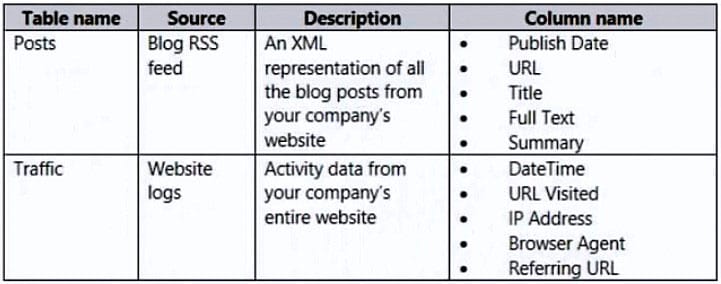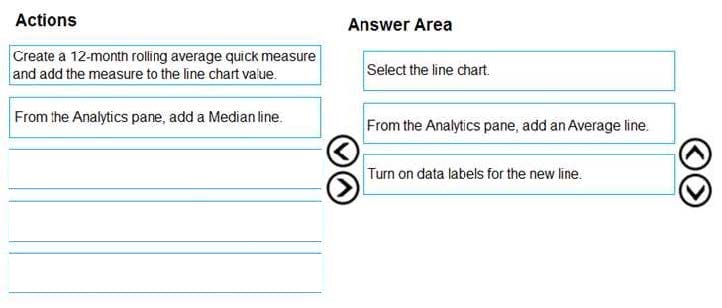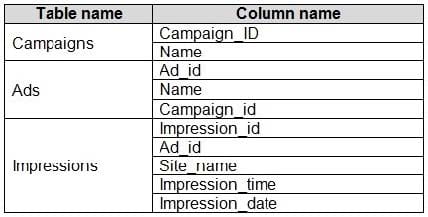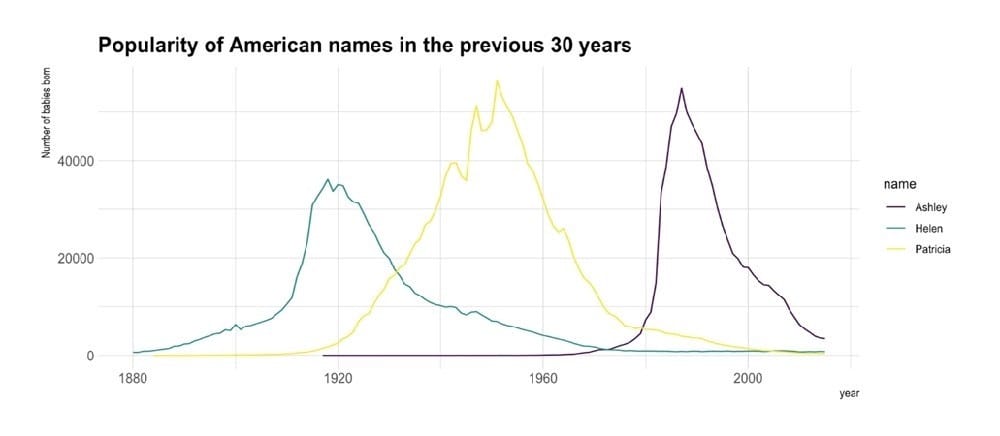
New Leads4Pass PL-300 Dumps has updated a total of 312 latest exam questions and answers in 2024, with detailed answer analysis, fully covering all core questions of the complete “Microsoft Power BI Data Analyst” PL-300 exam. In 2024 The exam feedback statistics for January and February of this year are 100% successful!
Therefore, candidates download New Leads4Pass PL-300 Dumps: https://www.leads4pass.com/pl-300.html, choose PDF or VCE tools to help you practice for the exam, and ensure that you can easily complete the target plan.
Leads4Pass Pl-300 dumps analysis of real exam questions
| From | Number of exam questions | Format | Type | Related certifications |
| Leads4Pass | 15 | 1. Question number 2. Exam questions 3. Answers to exam questions 4. Exam question analysis (analyze each option) 5. Reference (questions) | Free | Fundamentals, Role-based |
Question 1:
You are reviewing a query that produces 10,000 rows in the Power Query Editor.
You need to identify whether a column contains only unique values.
Which two Data Preview options can you use? Each correct answer presents a complete solution.
NOTE: Each correct selection is worth one point.
A. Column profile
B. Column distribution
C. Show whitespace
D. Column quality
E. Monospace
Correct Answer: AB
Exam question analysis:
B: Column distribution: This feature provides a set of visuals underneath the names of the columns that showcase the frequency and distribution of the values in each of the columns. The data in these visualizations is sorted in descending
order from the value with the highest frequency.
By hovering over the distribution data in any of the columns, you get information about the overall data in the column (with distinct counts and unique values).
A: Column profile: This feature provides a more in-depth look at the data in a column [compared to column distribution]. Apart from the column distribution chart, it contains a column statistics chart.
Reference:
https://docs.microsoft.com/en-us/power-query/data-profiling-tools
Question 2:
HOTSPOT
You are creating a column chart visualization.
You configure groups as shown in the Groups exhibit. {Click the Groups tab.)

The visualization appears as shown in the Chart exhibit. (Click the Chart tab.)

For each of the following statements, select Yes if the statement is true. Otherwise, select No. NOTE: Each correct selection is worth one point.
Hot Area:

Correct Answer:

Question 3:
You have a Power Bl report for the marketing department. The report reports on web traffic to a blog and contains data from the following tables.

There is a one-to-many relationship from Posts to Traffic that uses the URL and URL Visited columns. The report contains the visuals shown in the following table.

The dataset takes a long time to refresh.
You need to modify Posts and Traffic queries to reduce toad times.
Which two actions will reduce the toad times? Each correct answer presents part of the solution. NOTE: Each correct selection is worth one point.
A. Remove the rows m Traffic in which Traffic [Referring URL] does not start with “/”
B. Remove the rows in Posts in which Post [Publish Date] is in the last seven days.
C. Remove Traffic [IP Address], Traffic (Browser Agent], and Traffic [Referring URL).
D. Remove Posts [Full Text] and Posts [Summary].
E. Remove the rows in Traffic in which Traffic [URL visited] does not contain “blog\’\’
Correct Answer: DE
Exam question analysis:
D. These two columns are not used in the visuals and can be removed.
E. Only blog post rows are useful for the visuals.
Incorrect:
Three visuals need historical data.
Traffic[Referring URL] is used in one of the visuals and therefore cannot be removed.
These rows are used in 3 visuals.
Question 4:
DRAG DROP
You have the line chart shown in the exhibit. (Click the Exhibit tab.)

You need to modify the chart to meet the following requirements:
1.
Identify months that have order counts above the mean.
2.
Display the mean monthly order count.
Which three actions should you perform in sequence? To answer, move the appropriate actions from the list of actions to the answer area and arrange them in the correct order.
Select and Place:

Correct Answer:

1.
Select the line chart
2.
Add the average line
3.
Turn on Data Label
Reference: https://community.powerbi.com/t5/Desktop/Moving-Average/td-p/43041
Question 5:
HOTSPOT
You need to design the data model and the relationships for the Customer Details worksheet and the Orders table by using Power BI. The solution must meet the report requirements.
For each of the following statements, select Yes if the statement is true, Otherwise, select No.
NOTE: Each correct selection is worth one point.
Hot Area:

Correct Answer:

Exam question analysis:
1) NO – CustomerID in Orders is text (“VINET”) while CustomerID in Customer Details is number (“1”).
2) YES – Relationship between Orders and Customer Details will be via column CustomerCRMID in Customer Details and CustomerID in Orders, which are both text.
3) NO – the Orders table only contains the shipping address, which is different from the billing address which should be used for sales region. Thus, it should come from Customer Details table.
Question 6:
What should you do to address the existing environmental data concerns?
A. a calculated column that uses the following formula: ABS(Sales[sales_amount])
B. a measure that uses the following formula: SUMX(FILTER(\’Sales\’, \’Sales\'[sales_amount] > 0)),[sales_amount])
C. a measure that uses the following formula: SUM(Sales[sales_amount])
D. a calculated column that uses the following formula: IF(ISBLANK(Sales[sales_amount]),0, (Sales[sales_amount]))
Correct Answer: B
Exam question analysis:
A. Calculated Column with ‘ABS(Sales[sales_amount])‘:
This option transforms each sales amount into its absolute value. While it ensures there are no negative values, it doesn’t selectively focus on original positive values only. It modifies negative values to positive, which might not be desired if the goal is to analyze genuinely positive sales transactions.
B. Measure with ‘SUMX(FILTER(‘Sales‘, ‘Sales'[sales_amount] > 0), [sales_amount])‘:
Correctly specified, this measure filters the sales data to include only rows where the sales amount is greater than zero and then sums these amounts. This approach directly addresses concerns of focusing analysis on positive sales amounts, excluding negative values without transforming them. This is ideal for analyzing data where the goal is to aggregate positive contributions only, ensuring the analysis reflects actual sales without the influence of returns or negative transactions.
C. Measure with ‘SUM(Sales[sales_amount])‘:
This option sums all sales amounts, including both positive and negative values. While it is a straightforward way to aggregate sales data, it does not address the specific concern of focusing on positive sales amounts. Negative values (which could represent returns or other deductions) are included in the total sum, potentially skewing analysis if the intent is to understand positive revenue generation.
D. Calculated Column with ‘IF(ISBLANK(Sales[sales_amount]), 0, Sales[sales_amount])‘:
This formula replaces blank or missing values in the sales amount column with 0 but does not differentiate between positive and negative sales amounts. It ensures that missing data does not interfere with aggregate calculations but does not address the filtering of sales data based on the value being positive.
Given a more detailed analysis with the clarification that the correct answer is B, it’s clear that option B is the best choice for addressing concerns related to focusing on positive sales data. This measure ensures that only sales amounts greater than zero are considered in the sum, aligning with objectives that might include analyzing revenue generation or positive financial impacts without the influence of negative transactions or returns.
Question 7:
You have a Power BI report for the procurement department. The report contains data from the following tables.

There is a one-to-many relationship between Suppliers to line items that uses the ID and Supplier ID columns. The report contains the visuals shown in the following table.

You need to minimize the size of the dataset without affecting the visuals. What should you do?
A. Remove the rows from Line items where LineItems[invoice Date] is before the beginning of last month
B. Merge Suppliers and Uneltems.
C. Group Lineltems by Lineitems[ invoice id) and Lineitems[invoice Date) with a sum of Lineitems(price).
D. Remove the Lineitems[Description] column.
Correct Answer: D
Question 8:
What is the minimum number of datasets and storage modes required to support the reports? (What is the minimum number of Power BI datasets needed to support the reports?)
A. two imported datasets
B. a single DirectQuery dataset
C. two DirectQuery datasets
D. a single imported dataset
Correct Answer: D
Exam question analysis:
The analysts responsible for each business unit must see all the data the board sees, except the profit and loss data, which must be restricted to only their business unit\’s data. The analysts must be able to build new reports from the dataset that contains the profit and loss data” => one dataset and two separate workspaces Reason: All data can be imported into one dataset also if these are two logical models. Shared dimensions can be consumed in both models.
Reports and additional materials can be shared with the board with an app. The “profit and loss” data model needs RLS for the analysts and the analysts must have just read access to the original workspace. In a separate workspace with contributors (or more rights), they can create new reports (with a live connection to the dataset).
It is also stated that the new reports must be shared so therefore no need to include them into the app. Import vs. DirectQuery: Due to RLS requirements an imported dataset is needed. It is not possible with file sources and Sharepoint lists.
Question 9:
HOTSPOT
How should you distribute the reports to the board? To answer, select the appropriate options in the answer area.
NOTE: Each correct selection is worth one point.
Hot Area:

Correct Answer:

Exam question analysis:
Box 1: Using a workspace membership
Scenario:
The company wants to provide a single package of reports to the board that contains custom navigation and links to supplementary information.
Note: Workspace is a shared environment for a group of people. You can have multiple Power BI content in a workspace. One workspace can have hundreds of dashboards, reports, and datasets in it.
Box 2: A mail-enabled Azure-Active Directory group
Scenario: Security Requirements
The reports must be made available to the board from powerbi.com. A mail-enabled Azure-Active Directory (security)group will be used to share information with the board.
Reference:
Question 10:
You have a CSV file that contains user complaints. The file contains a column named Logged. Logged contains the date and time each complaint occurred. The data in Logged is in the following format: 2018-12-31 at 08:59.
You need to be able to analyze the complaints by the logged date and use a built-in date hierarchy.
What should you do?
A. Apply a transformation to extract the last 11 characters of the Logged column and set the data type of the new column to Date.
B. Change the data type of the Logged column to Date.
C. Split the Logged column by using it as the delimiter.
D. Apply a transformation to extract the first 11 characters of the Logged column.
Correct Answer: C
Exam question analysis:
Simply create a custom table in Power Query, enter the date shown in the question into a column called Date, and then Split it by a delimiter. No need for spaces on either side of “at” Power BI takes care of the rest:
= Table.SplitColumn(#”Changed Type”, “Date”, Splitter.SplitTextByDelimiter(“at”, QuoteStyle.Csv), {“Date.1”, “Date.2”})
It will even automatically change the type to Date:
= Table.TransformColumnTypes(#”Split Column by Delimiter”,{{“Date.1”, type date}, {“Date.2”, type time}})
Question 11:
You have a Power BI workspace named BI Data that contains a dataset named BI Finance. You have the Build permission for the 81 Finance dataset but you do NOT have permissions for the workspace,
You need to connect to BI Finance and create a report.
Which actions should you perform? Each correct answer presents a complete solution.
NOTE: Each correct selection is worth one point.
A. From the Power BI service, create a dataflow to the dataset by using DirectQuery.
B. From Power BI Desktop, connect to a Dataverse data source.
C. From the Power BI service, create a new report and select a published dataset
D. From Power Bl Desktop, connect to a shared dataset
Correct Answer: BC
Exam question analysis:
A. From the Power BI service, create a dataflow to the dataset by using DirectQuery.
This option remains incorrect for the given scenario. Creating a dataflow in Power BI is a process for preparing and importing data, which does not directly involve connecting to an existing dataset for report creation. DirectQuery is a feature that allows you to maintain a live connection to your data source, but it’s more relevant for scenarios where you’re actively querying large datasets that are not feasible to import due to their size. It doesn’t align with the specific requirement of utilizing Build permission to create reports.
B. From Power BI Desktop, connect to a Dataverse data source.
Given this is one of the correct answers, the interpretation must be considered in the context of having Build permission on a dataset, potentially housed in Dataverse, which is Microsoft’s cloud-based storage option that integrates data across various applications and services. If the BI Finance dataset is indeed accessible through Dataverse and you have the necessary permissions to access this data from Power BI Desktop, this option allows you to create reports by leveraging the direct connection to the data stored in Dataverse. It would be a valid approach if the BI Finance data is part of a Dataverse environment.
C. From the Power BI service, create a new report and select a published dataset.
This action is correct and straightforward. With Build permissions for the dataset, you can directly create a new report in the Power BI service by selecting the BI Finance dataset. This method is one of the most direct ways to utilize your permissions to generate new reports without needing access to the workspace.
D. From Power BI Desktop, connect to a shared dataset.
Given the provided answers, this option was not marked as correct. However, connecting to a shared dataset in Power BI Desktop is typically a valid method for creating reports based on a dataset you have Build permission for, even if you don’t have workspace access. The discrepancy might suggest a misunderstanding or a specific context in the scenario that wasn’t fully detailed initially, such as if the dataset wasn’t shared in a manner that made it accessible through Power BI Desktop or if there was an assumption about the availability of the dataset specifically in Dataverse that made option B a better fit for this scenario.
Reflecting on the feedback, B and C are correct in scenarios where the BI Finance dataset is accessible through Dataverse (B) and when creating reports directly in the Power BI service using a published dataset (C). The context or specific setup of the BI Finance dataset might influence the applicability of these options, especially considering the unique integration possibilities with Dataverse.
Question 12:
Note: This question is part of a series of questions that present the same scenario. Each question in the series contains a unique solution that might meet the stated goals. Some question sets might have more than one correct solution, while
others might not have a correct solution.
After you answer a question in this scenario, you will NOT be able to return to it. As a result, these questions will not appear in the review screen.
You have a clustered bar chart that contains a measure named Salary as the value and a field named Employee as the axis. Salary is present in the data as numerical amount representing US dollars.
You need to create a reference line to show which employees are above the median salary.
Solution: You create an average line by using the Salary measure.
Does this meet the goal?
A. Yes
B. No
Correct Answer: B
Exam question analysis:
Instead, create a percentile line by using the Salary measure and set the percentile to 50%.
Note: The 50th percentile is also known as the median or middle value where 50 percent of observations fall below.
Reference:
https://dash-intel.com/powerbi/statistical_functions_percentile.php
Question 13:
Your company has training videos that are published on Microsoft Stream. You need to surface the videos directly in a Microsoft Power BI dashboard. Which type of tile should you add?
A. video
B. custom streaming data
C. text box
D. web content
Correct Answer: D
Exam question analysis:
The “Web Content” tile in Power BI dashboards allows you to embed external content, including videos from Microsoft Stream, directly into your dashboard. This is done by using the embed code provided by Microsoft Stream (or other video services) and adding it as a web content tile on your dashboard. This method is preferred for embedding various types of external content, including but not limited to videos, web pages, and other web-embeddable content, to enhance your Power BI dashboards with interactive or supplementary material.
Reference:
https://docs.microsoft.com/en-us/stream/portal-embed-video https://docs.microsoft.com/en-us/power-bi/create-reports/service-dashboard-add-widget#add-web-content
Question 14:
You have the tables shown in the following table.

The Impressions table contains approximately 30 million records per month.
You need to create an ad analytics system to meet the following requirements:
Present ad impression counts for the day, campaign, and Site_name. The analytics for the last year are required.
Minimize the data model size.
Which two actions should you perform? Each correct answer presents part of the solution.
NOTE: Each correct selection is worth one point.
A. Group the impressions by Ad_id, Site_name, and Impression_date.Aggregate by using the CountRows function.
B. Create one-to-many relationships between the tables.
C. Create a calculated measure that aggregates by using the COUNTROWS function.
D. Create a calculated table that contains Ad_id, Site_name, and Impression_date.
Correct Answer: AB
Grouping in power query reduces the number of rows in the impression table that is gonna be loaded in the model. Creating relationships doesn’t increase the size of the model.
Question 15:
You need to create a visualization that compares revenue and cost over time. Which type of visualization should you use?
A. stacked area chart
B. donut chart
C. line chart
D. waterfall chart
Correct Answer: C
Exam question analysis:
A line chart or line graph displays the evolution of one or several numeric variables. Data points are connected by straight-line segments. A line chart is often used to visualize a trend in data over intervals of time. a time series? Thus the line is often drawn chronologically.
Example:

Reference: https://www.data-to-viz.com/graph/line.html
Download 2024 Microsoft PL-300 dumps: https://www.leads4pass.com/pl-300.html (312 Q&A with detailed answer analysis), use PDF or VCE tools to help you practice the test easily, and ensure that you successfully pass PL- 300 Certification Exam